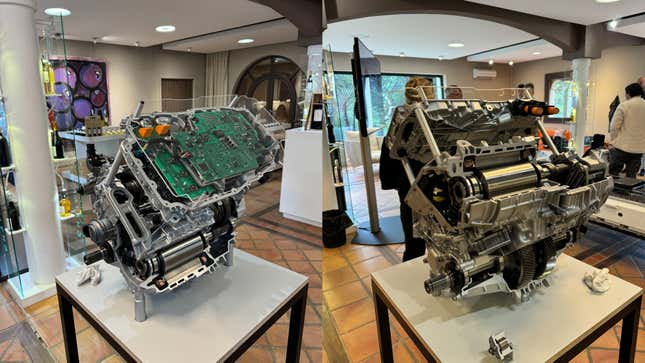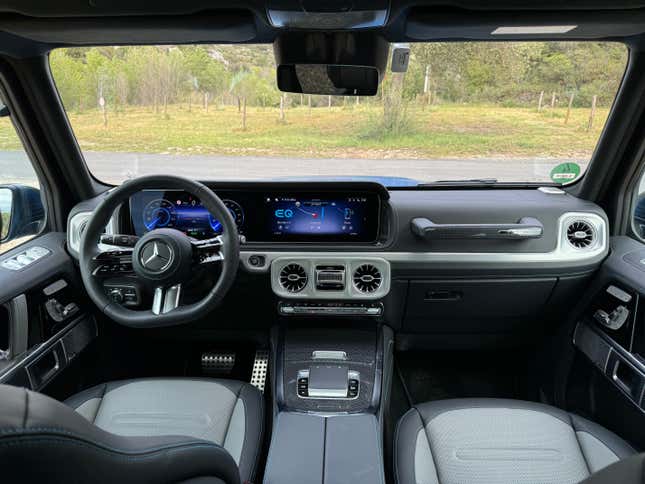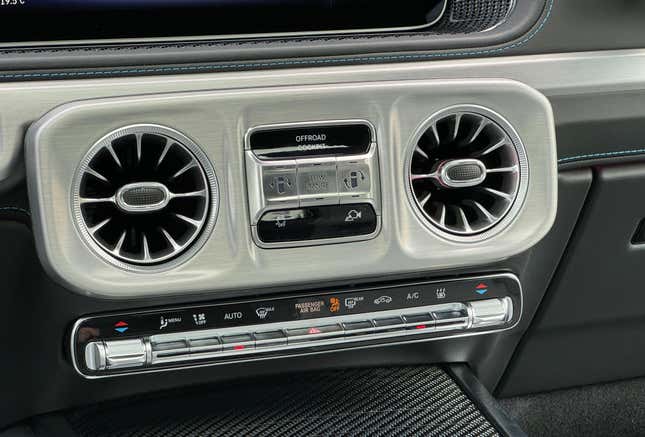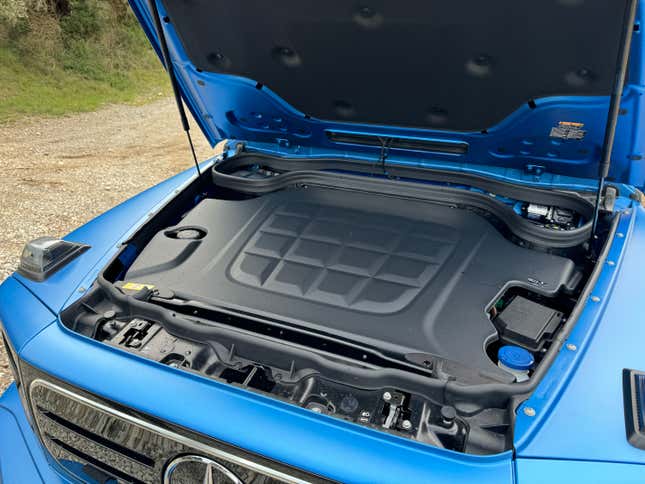Ever since I attended the Munich debut of the Mercedes-Benz Concept EQG in 2021, where it premiered with a Buck Rogers–style sci-fi mini film that featured design head Gorden Wagener alongside people in alien costumes, the electric G-Class has lived rent free in my brain. I can’t think of another new car I’ve been this excited about, and going to the Beverly Hills reveal of the production G-wagen EV at the end of April just amplified it.
Somehow, actually driving the electric G-wagen both on the paved roads around southern France and on some treacherous off-road courses at Mercedes’ global first-drive exceeded my pretty astronomical expectations. Not only is it better to drive on the road than gas-powered G-wagens, it’s even better in the rough stuff. Most importantly, the EV has all of the charm and personality that G-Class owners love so much; if I were blindfolded and put in one, I’d instantly know it was a G-Class.
Full disclosure: Mercedes-Benz flew me to Montpellier, France to drive the entire 2025 G-Class lineup, from the new inline-6 G550 to the hybridized G63 AMG and, of course, the electric G580. They put us up in two different fancy wineries, fed us amazing food including G-wagen–shaped cookies, and also let us drive a bunch of heritage G-Class models. I was grinning from ear-to-ear the entire time. Also, I finally watched Tenet on the plane ride home and did not like it.

The electric G-wagen’s official name is G580 with EQ Technology, which is a clunker. Mercedes is moving away from its EQ branding overall, thus why it isn’t called EQG, but the company wants to retain some of the EQ division’s branding and styling elements as it transitions to becoming a fully electric-only brand over the next decade. Naming it G580 makes it clear that this is still just a G-Class at the end of the day, and Mercedes’ engineers, marketers and executives have agreed that no one will refer to this car by its full name anyway — everyone will just call it “the electric G” or something similar. It’s a G-wagen, end of story.
But under the skin the electric G-Class is a radical departure from every G that came before it, the most thorough reworking of the model since the 2018 redesign (and probably even more so, honestly). The electric model had to retain the same ladder frame as the standard G, which was a challenge for packaging the batteries and other powertrain components as you can only fit so much within the existing platform. The G580 has a two-tiered 116-kWh lithium-ion battery pack that’s similar to the one found in the EQS, with all of the 216 cells contained within the ladder frame’s structure. The frame itself has been reinforced, too.

The G580 uses a quad-motor configuration — one of the only such setups in the industry along with Rimac and Rivian, though Mercedes was first to bring a quad-motor EV to production with the SLS Electric Drive back in 2013. Each of the G580’s 145-hp motors has its own centrally shifted two-speed transmission and the front and rear motors are each built into a shared housing that contains two motors, transmissions, and a double inverter. Total output is 579 horsepower and 859 pound-feet of torque, 2 hp and 232 lb-ft more than the new mild-hybrid G63 AMG and 136 hp and 446 lb-ft more than the new mild-hybrid six-cylinder G550. The motors are mounted directly to the ladder frame, with dual-joint driveshafts that have slip joints connecting them to the wheels. While the G580 has an independent double-wishbone front suspension like other G-wagens, the rear axle uses a newly developed De Dion setup, which Mercedes says means camber doesn’t change with compression.

The EV needed to look like a G-wagen, so there are only a couple of tells that you’re looking at an electric one. As standard it has the same four-bar grille and front air intakes as the G550, which also eschews exposed exhaust tips. The electric G has a slightly taller hood bulge and air curtains ahead of the rear wheels, plus EQ badges on the fenders, but otherwise it looks identical to the gas-powered G’s. Add the available AMG Line package and you get wider fender flares, and of course the G580 can be had with a few different Night Packages that black out much of the trim, as well as some other design packages and exterior trim options.
If you want to make sure people know your G-wagen is electric, there are a few options you can choose. The first is the black panel grille treatment, which gives the G580 a mostly blocked-off grille with four thin horizontal slats and a chrome grille border that illuminates with the headlights, plus a glossy black surround that extends to surround the headlights. I think this setup looks extremely cool, especially if you go for the optional black fender flares and bumpers, and it’s a nice retro nod to the original G-wagen’s front end.

The other option is the Design Box at the rear that replaces the traditional spare tire. This rounded rectangle is hinged on the same side as the tailgate itself, opening up to reveal a surprisingly large storage compartment that has a dedicated space for the charging cable, plus cubbies and nets for other items. At least on the Edition One models, the exterior of the box has a split color setup, with the upper section being black to blend in with the lines of the rear window. I really like the Design Box, and I think most owners would get more use out of it than the spare tire, though it’s great that both are available. Monster 4×4 Squared models aside, the G580 is also the first G-Class to offer a spare tire delete from the factory, putting the Mercedes star low down on the tailgate and adding a subtle blank panel where the spare tire mount would be.

Almost nothing about the cabin lets you know this G-wagen is electric, either. There are some EV-specific information menus and gauge cluster designs… and that’s basically it. Finally the G-Class gets a central touchscreen running the MBUX infotainment system, a huge upgrade over the old Comand setup, and it has Mercedes’ excellent voice assistant. The dashboard climate controls have been streamlined, and there’s a new steering wheel. Visually zhuzhing up the interior are additional ambient lighting strips, climate-controlled cupholders and new trim elements. Probably the biggest deal for existing owners is the addition of keyless entry for the first time on a G-wagen, including for the swing-out tailgate, without losing the bolt-action rifle locks or the heft of the doors and the tactile experience you get with the latches.
From the moment I set off, the G580 feels just like any other G-wagen in terms of overall character, but it’s improved in some important ways. The steering feels heftier than the G550’s, which I think is a positive, and it’s still easy to drive with just a few fingers or a light touch. Though it has regular steel springs with adaptive dampers, the ride quality is much better than on a G550 or standard G63, it soaks up more road imperfections, and the suspension has pitch and roll stabilization but still allows enough of the classic G-wagen lean in corners. I wish the G580 was available with the G63’s new Active Ride hydraulic suspension, which massively changes the G’s dynamics, but the G580 is still a better experience than the G63 without it.

Despite being about half a second slower to 60 mph than the V8-powered G63 — Mercedes quotes a 4.6-second 0-to-60-mph time, versus 4.2 seconds for the G63 and 5.3 seconds in the six-cylinder G550 — the G580 feels much quicker in real life. As you can see from my video below, it doesn’t lose steam as the speed rises, surging forwards towards a 112-mph top speed. Flooring it is giggle-inducing; like with other G-wagens the whole front end rises up like a boat under acceleration – it’s fun, it still feels controlled. The powertrain is so much more responsive than even the G63’s V8, and the torque vectoring capabilities mean I can carry more speed into a corner and accelerate harder coming out of one without worrying about whether this big tank can handle it. Every G-wagen is giggle-inducing to drive, and the G580 is no exception.
Every 2025 G-Class is much quieter than last year’s model thanks to a bunch of small aerodynamic tweaks, like a smoother A-pillar and a new spoiler at the leading edge of the roof, that were mainly implemented to improve the EV’s range. The electric G also has more sound insulation, and it’s easily the quietest G-wagen ever, with acoustic comfort worthy of the vault feeling you get from slamming the door. At higher speeds some wind noise still penetrates — there’s no getting around how upright and flat the greenhouse is — but it’s much more luxurious overall.
Other than how it looks, potentially the most crucial thing about the G580 is how it sounds, doubly so with the interior being such a calm environment. For decades now G-wagens have been known for their side-exit exhaust tips and signature rumbling engine note and both are absent on the EV. Instead, Mercedes developed what it calls G-Roar, described as a “an impressive acoustic accompaniment to the acceleration with deep bass and sonorous tones.” The sounds aren’t very intense when tootling around in Comfort, but in Sport mode the G-Roar really comes alive. It doesn’t sound like an engine, per se, but it offers many of the same auditory sensations that the G63’s V8 does. It burbles at low speeds, with an intense waffling sound getting louder under acceleration. The sounds are audible from outside the car too. Like other EV sounds it certainly won’t be for everyone, but I absolutely love it.
There are five different levels of regenerative braking in the G580, including a no-regen mode and an auto mode that adjusts the recuperation according to your driving and the traffic ahead. The most intense of the five settings doesn’t quite give the G580 one-pedal driving, which is a shame, but with 217 kW of recuperation capability the regen is strong enough to get almost all of the work done, and it even takes me a bit to get used to how aggressive the initial deceleration is. Luckily the G580 isn’t plagued with the moving-pedal feature that Mercedes’ early EQ models had. Regenerative braking is one of the most transformative additions to the G-wagen’s driving experience, and it’s one of the things I miss the most when I jump back into a G550 after driving the EV.

I don’t have enough time in the G580 to get a sense of its real-world range, but it will be more than enough for the average G-wagen owner. In Europe the G580 has a maximum range of 295 miles on the WLTP cycle, which will likely work out to around 250 to 275 miles in the U.S. EPA cycle. Sure, in the grand scheme of EVs that’s not a lot, but the gas-powered G-wagens get such shitty gas mileage that most owners will probably find it to be an improvement. I mean, the current G63 is rated at 13 mpg in the city, and in the real world it’s much worse than that — the 2025 G63’s mild-hybrid setup will help, but not by a significant amount.
The G580 supports DC fast-charging of speeds up to 200 kW, good enough to go from 10 to 80 percent charge in 32 minutes. Mercedes says basically all owners will charge at home anyway, and G-Class owners would typically take one of their other cars if they need to do a road trip. But if the range is really a concern, like for those that want to do longer-distance off-roading or overlanding, Mercedes says that in a few years the G580 will become available with new silicon-anode batteries that will boost energy density by 40 percent and increase range by around 100 miles.
So, the electric G-wagen is fantastic on road, where commenters will say that most of them will spend all their time anyway, but a G-Class still needs to be the best off-roader possible no matter the powertrain — and the EV is. The G580’s 9.8 inches of ground clearance is 0.3 inches greater than a G550, and its approach and departure angles are slightly better as well, though the breakover angle is 5.7 degrees worse. It can climb a 100-percent grade just like other G-wagens, and it is stable on sideways slopes of up to 35 degrees.

Mercedes has set up an hour-long off-road course that snakes around the winery’s hills, for which I swap into a different G580, this one painted Sand Beige with the available 18-inch wheels wearing Falken Wildpeak A/T all-terrain tires. (If you want this setup, you sadly can’t choose the AMG Line that adds wider rear fenders.) This is no beginner’s course, either. It’s been raining all day, so there are more mud puddles and washed-out sections than Mercedes anticipated, and the course is full of deep ruts, challenging rock-crawling sections and other hazards.
One of the G-wagen’s longtime signature features are its lockable differentials, of which modern models have three, but the electric G580 doesn’t have any diff lockers — at least, not “real” ones. Thanks to the quad-motor setup, the G580 uses torque vectoring to create virtual differential locks that work automatically, controlling the torque at each wheel within fractions of a second. Whether you’re sliding around like a rally driver or slowly climbing a rocky hill, the G580 is always getting the optimum amount of power and traction to each wheel.
What’s not virtual is the G580’s Low Range, an actual off-road 2:1 gear reduction that’s available in the Rock drive mode, which is what I stay in for the whole drive. Low Range works at up to 53 mph, and Mercedes says the car’s handling and response characteristics change when it’s activated. In Low Range the motors are putting out 3,319 lb-ft of torque; Mercedes’ engineers say that figure could be much higher but that would be unnecessary.

When Low Range is activated, using a button in the center of the dash where the diff lockers normally would be, the G580’s crawl control function is immediately turned on as well. It basically works like an off-road cruise control, controlled by the same steering wheel paddles that normally control regen braking. In the slowest setting the car maintains a speed of just 1 mph, while in the fastest setting the G580 goes 5 mph on level or uphill terrain and has no set speed while going downhill, instead using the recuperation to slow the vehicle depending on how steep the grade is. The middle setting is called “variable crawl,” and it keeps the car at a walking pace.
In any of the three settings the driver is still able to accelerate or brake if needed, and the car will return to the crawl speed after or maintain the speed you’ve adjusted to. The crawl control works in reverse too, as the G580 in front of me demonstrates by backing up a very steep, rocky hill. It looks like footage being played in reverse, like it shouldn’t be possible to do in real life. Not needing to do any acceleration or braking inputs makes off-roading much less stressful, especially when going up a steep grade or through a particularly tricky section, and the overall quietness of the cabin adds to the calmness. I can hear the motors whirring as rocks ping against the underbody, and it’s easy to hold a conversation with my passenger and enjoy the sounds of nature while still focusing on the trail. The G-Class also has a new transparent hood feature that uses the surround-view cameras to show a virtual view of what’s underneath the front end.

One of the most common concerns with electric off-roaders is protecting the battery pack, and Mercedes has that taken care of. Covering nearly the entire underbody is a one-inch-thick shield panel that’s two thin pieces of carbon sandwiching a special composite that Mercedes won’t talk about yet, with a layer of stone-chip protection added on. The panel weighs just 127 pounds, one-third of what a steel panel would be, it’s bolted onto the frame with 50 steel fasteners so it can easily be replaced if needed. The battery, motor housings, suspension components and other important parts are also designed to withstand dust, water, and other extreme conditions and wear.
The G580 can also ford water up to 33.5 inches deep, 5.9 inches greater than the gas-powered G’s, which I get to experience by driving through an opaque muddy river. My Mercedes engineer co-pilot remarks that because of the rain this water crossing is more like 35.5 inches deep, but the G580 makes it through no problem, using crawl control to wade through at a higher set speed. The EV’s silence definitely makes water coming up to the top of the hood even more nerve-wracking, though.

We come to a stop in a muddy parking lot to try out G-Turn, the electric G-wagen’s biggest party trick. It’s easy to activate, though it does take a few steps. With one foot on the brake, first you press the G-Turn button on the dash next to Low Range, and then you hold down the steering wheel paddle that’s in the direction you want the car to spin. While holding the paddle and keeping the steering wheel perfectly straight — even a slight turn will cancel the motion — put your right foot on the accelerator, release the brake, and the car starts spinning perfectly in place. Most people will probably use G-Turn to make bystanders stare in awe and laugh (and Mercedes says it should not be used on pavement), but it will be a genuine help if you need to turn around on a trail or get around an obstacle.
If it looks hilarious from outside the car, it’s even funnier when you’re inside the car experiencing it. There are no strange noises or unsettling vibrations, there’s no body roll or suspension flex. The G-wagen stays totally flat and stable as it spins around — at quite a high speed, I might add. It’ll do just over two full rotations before coming to a stop, though the driver can immediately cancel the spin at any time by letting go of the paddle, taking their foot off the accelerator or turning the steering wheel. You can keep activating the G-Turn over and over again, too.
Not as impressive visually but useful in even more situations is the G-Steering function, which is toggled by the third locker-replacing button on the dash. By controlling the torque being sent to each wheel and locking one or both of the inner wheels if needed, G-Steering greatly reduces the G580’s turning radius. The course has a bunch of corners that would be far too tight for a G to get around normally without making a three-point turn, but with G-Steering active I’m able to drive around them with ease. It works at up to 15 mph, and the function will stay on for a long time if you don’t turn it off.
It’s a bit of a weird sensation, kind of like drifting but without the rear end being actually kicked out. The action is extremely linear; the amount that I think I need to turn the steering wheel to get around the corner is the exact right amount, I don’t need to make any little corrections or adjustments partway through. Mercedes also has us do a slalom course through the mud, with the cones placed so close together that basically no car could do it, let alone a G-wagen. But with G-Steering turned on, the G580 easily rotates around each cone. Combined with the G-Class’ relatively small footprint, the G-Steering will open up a lot more trail possibilities that previous models couldn’t navigate. I only scratch the surface of the G580’s capabilities, so I can’t wait to take one on some long off-roading trips in California.

Mercedes hasn’t announced pricing for the U.S. market yet, but if it’s anything like the German pricing, the G580 EV might be the best deal in the G-Class lineup. With the mandatory 19-percent VAT tax included, the G580 starts at just under €143,000, the equivalent of about $154,000. That’s only €11,000 (about $12,000) more than the new G500 (sold as the G550 in America). In the U.S. the current V8 G550 starts at $144,150 including destination, and the refreshed inline-6 model might be closer to $150,000. If the electric G-wagen comes in at around $170,000 — fifteen grand less than the G63 — I think that’ll be a hell of a deal.
When the G580 hits U.S. dealer lots in the second half of this year, it’ll only come in Edition One form. Basically the launch edition, this model is restricted to just five colors and will come fully loaded, with special badges, blue accents on the exterior trim strips and interior carbon fiber, and some other unique styling bits. Expect Edition Ones to cost at least $200,000, before you add any markups (and there will be markups). If you want to spec your electric G-wagen yourself — and you should — the 2026 model will probably become available in early spring. Through Mercedes’ Manufaktur program, G-Class customers have over one million possible color and trim option combinations, with more than 20,000 paint colors to choose from and the ability to create bespoke specs.

Mercedes doesn’t have any specific sales targets for the EV, and there are no plans for an expansion of the Graz factory, though the company admits it would be possible in the future. No, the G-wagen will stay a purposefully limited commodity, even though Mercedes is making more than ever. In 2023 more than 10,000 G’s were sold in the U.S. alone, almost beating the S-Class, and here the G63 vastly outsells the G550 — I’ve heard the sales split currently sits at around 80 percent for the AMG. G-Class production is flexible, so Mercedes is prepared for any level of EV demand and can adjust output accordingly.
In a roundtable at the launch, Michael Schiebe, AMG CEO and head of the G-Class division, said he thinks the EV could become the most popular G-wagen model by the end of the decade, especially in countries like China, and he expects the EV will both bring in new customers and conquests to the brand and hold major appeal to existing G-wagen owners. The G-Class has the second-wealthiest owners in the Mercedes brand, second only to Maybach, and its average customer is getting younger and more accepting of electrification. As for the potential of an electric AMG variant, Schiebe wouldn’t talk about any official plans, but the glint in his eye and the smile on his face basically confirmed it’ll happen eventually.
The G-wagen seemed like it would be one of the last vehicles to convincingly go electric, and one of the most difficult customer bases to convert, but the G580 with EQ Technology proves it’s actually the ideal candidate. The electric G-Class is just as lovable as its gas-powered siblings, with its own unique character and unmatched off-road performance. I think it’s a home run, a smash hit, a tour de force, whatever other turn of phrase you can think of. I badly want one, no, I need one, and that’s exactly how a G-wagen should make you feel.



Barbara Terrio is a seasoned business journalist, delving into the world of finance, startups, and entrepreneurship. With a knack for demystifying complex economic trends, she helps readers navigate the business landscape. Outside of her reporting, Barbara is an advocate for financial literacy and enjoys mentoring aspiring entrepreneurs.








